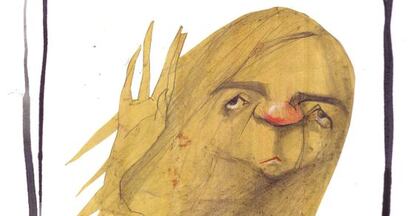The obstinacy of Princess Cristina
The king’s sister is seen as a burden after remaining loyal to her husband throughout the Nóos case


For a long time, Cristina de Borbón represented the modern side of Spain’s royal family. Born in 1965, she was the first female Spanish royal to earn a university degree (in political science); in 1991 she told reporters that she would marry for love and that her husband would be a normal, uncomplicated man; in 1992 she shared a Barcelona apartment with a girlfriend from her sailing circle; and in 1993 she started working for bank La Caixa on a monthly salary of €1,200.
The most independent member of Spain’s royal family was also one of its most beloved. The day she married Olympic handball player Iñaki Urdangarin in Barcelona, 200,000 people came out to applaud as the new Duke and Duchess of Palma went by. That was in October 1997.
Fifteen years later, “popular indignation” led the city of Palma de Mallorca to change the sign on a street that had been named in their honor: it is now known simply as La Rambla. The title of the Duke and Duchess of Palma had been a surprise wedding gift from Cristina’s father, King Juan Carlos.
Once in high demand to hand out prizes at ceremonies, attend public events and represent the Spanish Crown, Cristina sealed her own fate when she decided to remain loyal to her husband after he had morphed from a perfect son-in-law to a “toxic man” following the Nóos scandal.
On February 8, the Infanta was forced to go down the “slope of shame” that leads to the Palma courthouse
They met in the summer of 1996, at an event organized by the Spanish Olympic Committee, and announced their engagement on April 30, 1997, after a nine-month relationship. Back then, Cristina was earning 200,000 pesetas (€1,202) a month at La Caixa, while Urdangarin had an annual salary of 10 million pesetas (€60,101) as a handball player for the Barcelona team. The 30-year-old sportsman was also completing a degree in business administration and seemed concerned about his job prospects. “I know it will be hard,” he told EL PAÍS.
But his lifestyle began experiencing exponential growth. In 2004, after taking out a loan from La Caixa and borrowing €1.2 million from Juan Carlos, the couple bought a luxury mansion in the exclusive Barcelona neighborhood of Pedralbes for €6 million. Refurbishing the place allegedly cost an additional €3 million.
So what happened in between this concern about making ends meet and the luxury home? Urdangarin did a master’s degree at the Esade business school in Madrid, where he met Diego Torres, his future business partner and the man who ultimately dragged Cristina de Borbón into a courthouse. At the height of the Nóos scandal, in March 2012, Torres became furious when Urdangarin’s lawyer objected to dropping Torres’ wife from the investigation. In revenge, he gave investigators reams of personal email exchanges containing compromising information relating to Urdangarin and his wife.
But not even this made Cristina distance herself an inch from her husband. She never offered to file for divorce or renounce her theoretical rights to the throne, even though surveys kept showing that the Nóos case was severely eroding the monarchy’s good standing.
The king’s public apology for his elephant-hunting expedition to Botswana went some way towards lifting the Crown’s popularity ratings again, but public support has yet to return to pre-Nóos levels.
Felipe has avoided being seen in public with his sister since the Nóos scandal broke
The Infanta is sixth in line to the throne, so renouncing her rights would have no practical consequences. It would not even affect her children, who would climb one rung in the succession ladder. Yet she never made such a gesture to her father, and neither did he ask for it. It remains to be seen whether she will offer it to the new king, her brother Felipe VI, depending on how her legal situation develops.
In any case, the Duke and Duchess of Palma have not appreciated the isolation tactics implemented by the former head of the Royal Household, Rafael Spottorno, in an effort to protect the king and the monarchy. Both Cristina and her husband viewed the strategy as an advance condemnation of their own persons. Then again, they never thought things would ever go this far.
Cristina was removed from the official royal schedule in October 2011, and did not even attend her father’s abdication ceremony or her brother’s coronation last week. Even though the two siblings had been very close, Felipe has avoided being seen in public with Cristina ever since the Nóos scandal broke.
The princess was convinced that she had become a scapegoat. The lawyer her father hired as her defense attorney, Miquel Roca, one of the founding fathers of the Spanish Constitution, quickly announced an appeal when the judge in charge of the case summoned her for questioning a second time. But the royal family convinced Cristina that it would be in her own best interest to give testimony, cut “the torture” short, and avail herself of this last chance to send out the message that she was cooperating with the justice system.
She never offered to file for divorce or renounce her right to the throne
Finally, on February 8, the Infanta was forced to head down the “slope of shame” that leads into the Palma courthouse, although she covered the distance in a car. Once inside, she gave evidence as an official suspect in a tax fraud and money laundering investigation in connection with her husband’s questionable sources of funding through the Nóos Institute.
Nobody from the royal family was there with her, just her lawyers, who had trained her for something that no monarch’s child is ever trained to do: provide explanations.
“I trusted my husband,” was the phrase she repeated many times over in her court statement. But she failed to convince Judge Castro. “The endless resorting to the claim of ignorance and faulty recollection” shown by Cristina throughout the session made the magistrate decide not to drop the investigation against her. “Whether the explanation for this attitude resided in the trust, veneration or love that she professed for her husband is not for me to judge,” added Castro.
But sources at La Zarzuela, the royal residence, are blaming the stubborness of a woman in love for the decline in the monarchy’s popularity ratings, and for the first shadow cast over Spain’s new king.
Tu suscripción se está usando en otro dispositivo
¿Quieres añadir otro usuario a tu suscripción?
Si continúas leyendo en este dispositivo, no se podrá leer en el otro.
FlechaTu suscripción se está usando en otro dispositivo y solo puedes acceder a EL PAÍS desde un dispositivo a la vez.
Si quieres compartir tu cuenta, cambia tu suscripción a la modalidad Premium, así podrás añadir otro usuario. Cada uno accederá con su propia cuenta de email, lo que os permitirá personalizar vuestra experiencia en EL PAÍS.
¿Tienes una suscripción de empresa? Accede aquí para contratar más cuentas.
En el caso de no saber quién está usando tu cuenta, te recomendamos cambiar tu contraseña aquí.
Si decides continuar compartiendo tu cuenta, este mensaje se mostrará en tu dispositivo y en el de la otra persona que está usando tu cuenta de forma indefinida, afectando a tu experiencia de lectura. Puedes consultar aquí los términos y condiciones de la suscripción digital.
Últimas noticias
Most viewed
- Alain Aspect, Nobel laureate in physics: ‘Einstein was so smart that he would have had to recognize quantum entanglement’
- David King, chemist: ‘There are scientists studying how to cool the planet; nobody should stop these experiments from happening’
- Maps of the US attack on Venezuela: Targets, airspace and deployed fleet
- Key points of the military attack on Venezuela: Early morning bombings and a ‘captured’ president
- Trump says Washington will control Venezuela until there is ‘a safe transition’








































